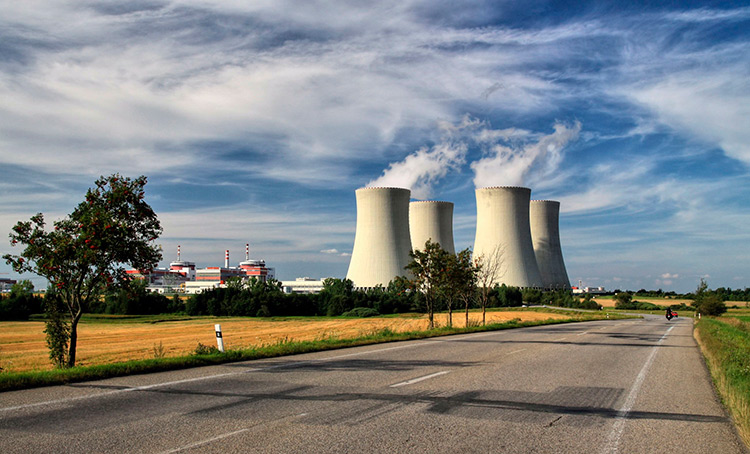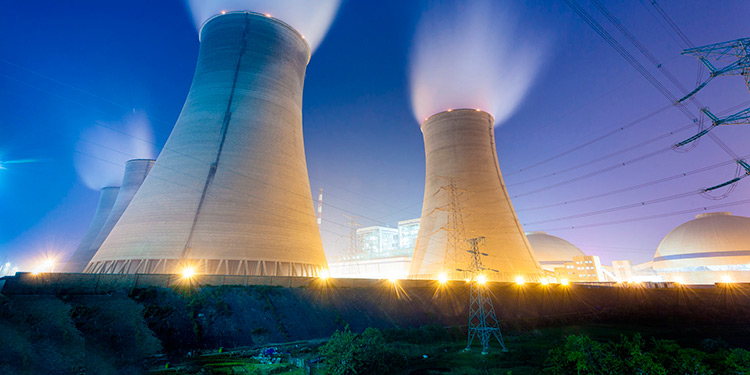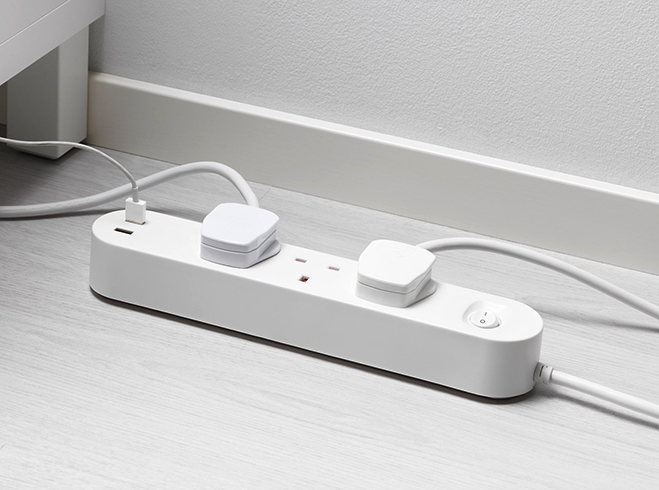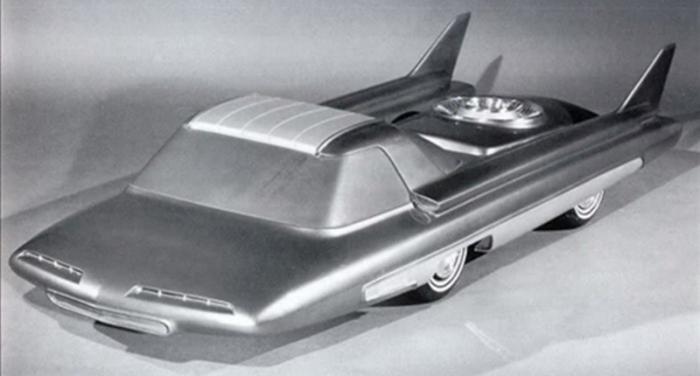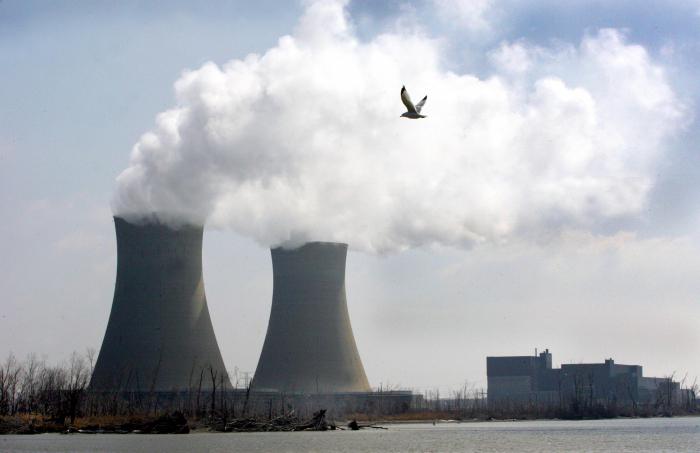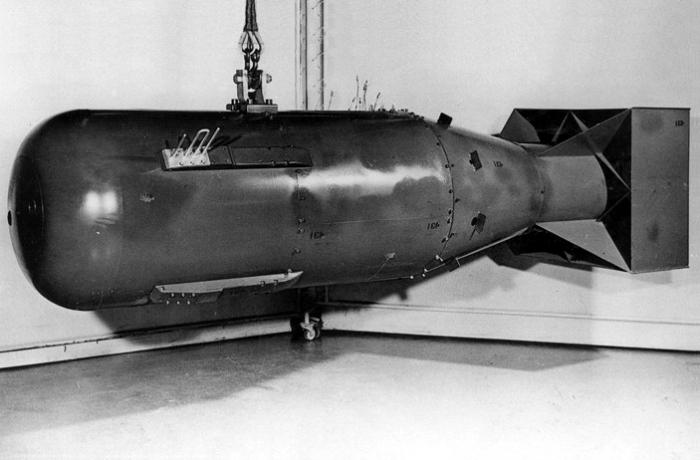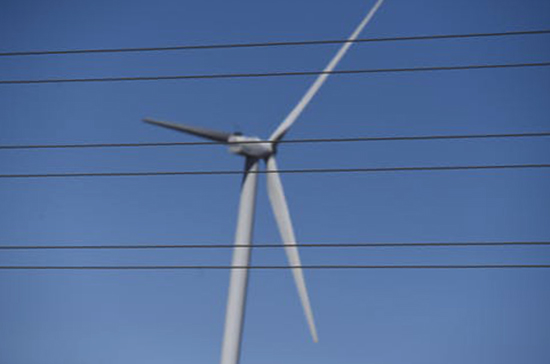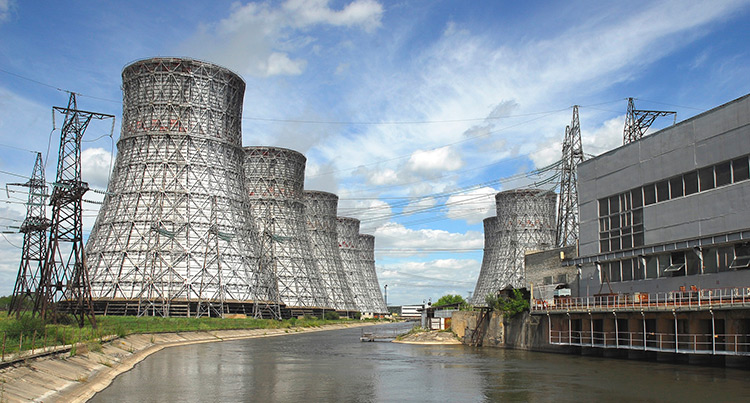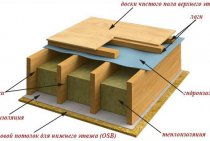Thermal power engineering. Advantages and disadvantages
Thermal power engineering is one of the main components of the energy industry and includes the process of generating thermal energy, transportation, considers the main conditions for energy production and the side effects of the industry on the environment, the human body and animals. thermal power engineering humanity nuclear
The process of production of thermal energy is carried out at thermal power plants (TPP) and thermal power plants (CHP). These two types of enterprises are currently the main suppliers of thermal and electrical energy, since these types of energy resources are very closely related. At present, the local system of supply of thermal energy, which is used both in large industrial enterprises and for heating residential areas, is widely used.
In accordance with the established terminology, thermal power includes the receipt, processing, transformation, storage and use of energy resources and energy carriers of all types.
According to the definition, thermal power engineering has developed external and internal communications and its development is inseparable from all areas of human life associated with the use of energy (in industry, agriculture, construction, transport and at home).
The development of thermal power engineering is characterized by an acceleration in growth rates, a change in all quantitative indicators and the structure of the fuel and energy balance, a global coverage of all types of fossil fuel resources, and involvement in the use of nuclear fuel.
In general, there are four main stages in the transformation of primary thermal resources (from their natural state, which is in dynamic equilibrium with the environment, to final use).
- 1. Extraction, extraction or direct use of primary natural resources of thermal energy.
- 2. Processing (upgrading) of primary resources to a state suitable for transformation or use.
- 3. Converting the associated energy of processed resources into thermal energy at thermal power plants (TPP), central plants (CHP), boiler houses.
Advantages:
l relative cheapness of production;
l the possibility of rapid construction of stations;
l Sufficient, for today, fuel reserves;
Flaws:
l limited resources;
L non-environmental friendliness, a large amount of waste and harmful emissions;
large losses of fuel energy during its generation;
the need to transport fuel;
l damage to nature and ecology during fuel extraction;
Disadvantages of alternative energy sources
Nuclear, hydro and thermal power plants are the main sources of electricity in the modern world. What are the advantages of nuclear power plants, hydroelectric power plants and thermal power plants? Why are we not warmed by wind energy or the energy of sea tides? Why did scientists not like hydrogen or the natural heat of the Earth? There are reasons for that.
The energies of wind and sun and sea tides are usually called alternative because of their rare use and very recent appearance. And also due to the fact that the wind, the sun, the sea and the heat of the Earth are renewable, and the fact that a person uses the heat of the sun or the sea tide will not bring any harm to either the sun or the tide. But do not rush to run and catch the waves, not everything is so easy and rosy.
Solar energy has significant disadvantages - the sun shines only during the day, so at night you will not get any energy from it. This is inconvenient, because the main peak of electricity consumption occurs in the evening hours. At different times of the year and in different places on Earth, the sun shines differently. Adjusting to it is costly and difficult.
Wind and waves are also wayward phenomena, they want to blow and tide, but they don’t want to. But if they work, they do it slowly and weakly. Therefore, wind energy and tidal energy have not yet received wide distribution.
Geothermal energy is a complex process, because it is possible to build power plants only in zones of tectonic activity, where maximum heat can be "squeezed" out of the ground. How many places with volcanoes do you know? Here are a few scientists. Therefore, geothermal energy is likely to remain narrowly focused and not particularly efficient.
Hydrogen energy is the most promising. Hydrogen has a very high combustion efficiency and its combustion is absolutely environmentally friendly, because. combustion product is distilled water. But, there is one but. The process of producing pure hydrogen costs an incredibly large amount of money. Do you want to pay millions for electricity and hot water? Nobody wants. We are waiting, hoping and believing that soon scientists will find a way to make hydrogen energy more accessible.
Use of nuclear energy in agriculture
The use of nuclear energy in agriculture solves the problems of selection and helps in pest control.
Nuclear energy is used to create mutations in seeds. This is done to obtain new varieties that bring more yield and are resistant to crop diseases. So, more than half of the wheat grown in Italy for making pasta was bred using mutations.
Radioisotopes are also used to determine the best ways to apply fertilizers. For example, with their help, it was determined that when growing rice, it is possible to reduce the application of nitrogen fertilizers. This not only saved money, but also saved the environment.
A slightly strange use of nuclear energy is to irradiate insect larvae. This is done in order to display them harmlessly to the environment. In this case, the insects that emerged from the irradiated larvae do not have offspring, but in other respects are quite normal.
Advantages of nuclear power plants over thermal power plants
The advantages and disadvantages of nuclear power plants depend on what type of electricity generation we compare nuclear energy with. Since the main competitors of nuclear power plants are thermal power plants and hydroelectric power plants, let's compare the advantages and disadvantages of nuclear power plants in relation to these types of energy generation.
Thermal power plants, that is, thermal power plants, are of two types:
- Condensing or short CPPs serve only for the production of electricity. By the way, their other name came from the Soviet past, IES is also called GRES - short for "state regional power plant".
2. Combined heat and power plants or CHPPs allow only the production of not only electrical, but also thermal energy. Taking, for example, a residential building, it is clear that the IES will only provide electricity to the apartments, and the CHP will also provide heating in addition.
As a rule, thermal power plants operate on cheap organic fuel - coal or coal dust and fuel oil. The most demanded energy resources today are coal, oil and gas. According to experts, the world's coal reserves will be enough for another 270 years, oil - for 50 years, gas - for 70. Even a schoolboy understands that 50-year reserves are very few and they must be protected, and not burned daily in furnaces.
IT'S IMPORTANT TO KNOW:
Nuclear power plants solve the problem of fossil fuel shortage. The advantage of nuclear power plants is the rejection of fossil fuels, thereby preserving the disappearing gas, coal and oil. Instead, nuclear power plants use uranium. The world reserves of uranium are estimated at 6,306,300 tons. No one considers how many years it will last, because. there are many reserves, the consumption of uranium is rather small, and it is not yet necessary to think about its disappearance. In the extreme case, if aliens suddenly carry away uranium reserves or they evaporate by themselves, plutonium and thorium can be used as nuclear fuel. Converting them into nuclear fuel is still expensive and difficult, but possible.
The advantages of nuclear power plants over thermal power plants are also a reduction in the amount of harmful emissions into the atmosphere.
What is released into the atmosphere during the operation of IES and CHP and how dangerous it is:
-
Sulfur dioxide or sulfur dioxide
- a dangerous gas that is detrimental to plants. When ingested in large quantities, it causes coughing and suffocation. Combined with water, sulfur dioxide turns into sulfurous acid. It is due to sulfur dioxide emissions that there is a risk of acid rain, which is dangerous for nature and humans.
2. nitrogen oxides
- dangerous for the respiratory system of humans and animals, irritate the respiratory tract.
3. Benapyrene
- dangerous because it tends to accumulate in the human body. Long-term exposure may cause malignant tumors.
The total annual emissions of thermal power plants per 1000 MW of installed capacity are 13 thousand tons per year at gas and 165 thousand tons at pulverized coal thermal power plants. A thermal power plant with a capacity of 1000 MW per year consumes 8 million tons of oxygen for fuel oxidation, the advantages of nuclear power plants are that oxygen is not consumed in principle in nuclear energy.
The above emissions for nuclear power plants are also not typical. The advantage of nuclear power plants is that emissions of harmful substances into the atmosphere at nuclear power plants are negligible and, compared with emissions from thermal power plants, are harmless.
The advantages of nuclear power plants over thermal power plants are low fuel transportation costs. Coal and gas are extremely expensive to deliver to production, while the uranium needed for nuclear reactions can be placed in one small truck.
Minuses
- The electricity produced by the eastern regions is so large that it is not fully utilized. But in the central regions, there is a shortage of it, due to densely located settlements.
- Insufficient number of electric routes in the regions of Siberia and in the Far East regions. This problem should be solved by the construction of new routes, as well as the development of second tracks in areas where routes already exist.
- Grids can only carry electricity. In addition to electricity in the world, there are many more resources to be transported. Therefore, the problem of their transportation, in this case, is not solved.
- Little investment in the industry. The fact is, there is a lack of allocation of funds in this area. The issue can be resolved by attracting monetary investments of foreign capital, increasing the investment of citizens of the country.
- Lack of transport links with countries that have close proximity to Russia. Perhaps more attention should be paid to this issue, because at the moment its elaboration leaves much to be desired.
- Noise pollution from mobile networks. Telephone sources are also included in this industry. But they, as much as we would not like to believe it, cause colossal harm to nature. Due to the presence of a large number of networks penetrating the entire space of the country, there is a mass extinction of bees. These insects pollinate most of the plants. We risk falling into a global catastrophe, accompanied by world hunger and extinction, if we do not begin to solve this problem now.
- Harmful radiation received by people during communication via mobile communications. These are mainly microwave waves, they penetrate the human body completely, while talking on the phone. The negative effect of the impact has a cumulative property, the more a person is at the disposal of gadgets, the more he will suffer from headaches and various diseases.
It is difficult to overestimate all the benefits that e-transport has brought us. We have come a long way by inventing this kind of movement of electricity, information. But the negative consequences of such a step will not be long in coming. In the near future, humanity will have to solve the problem of the negative impact on the world around us as a whole.Perhaps you should think about it now, so as not to pay big losses in the near future.
Peaceful atom must live
1. TPP. Thermal Energy (electro) Stations. They are based on the processing (burning) of solid fuel carriers, such as coal.
1. Large amount of power generation.
2. The most easy to operate.
3. The very principle of operation and their construction are very simple.
4. Cheap, readily available.
5. Give jobs.
1. They provide less electricity than hydroelectric power plants and nuclear power plants
2. Environmentally dangerous - environmental pollution, greenhouse effect, require the consumption of non-renewable resources (like coal).
3. Due to their primitivism, they are simply obsolete.
HPP - Hydro Electro Station. Based on the use of water resources, rivers, tidal cycles.
1. Relatively environmentally friendly.
2. They give many times more electricity than thermal power plants.
3. May provide additional sub-production structures.
4. Jobs.
5. More easy to operate than nuclear power plants. .
1. Again, environmental safety is relative (dam explosion, water pollution in the absence of a purification cycle, imbalance).
2. High construction costs.
3. They give less energy than nuclear power plants.
NPP - Nuclear Power Plants. The most perfect at the moment ES in terms of power. Uranium rods of the uranium isotope -278 and the energy of an atomic reaction are used.
1. Relatively low resource consumption. The most important is uranium.
2. The most powerful power generation plants. One ES can provide entire cities and metropolitan areas, nearby areas, in general, cover vast territories.
3. More modern than thermal power plants.
4. Give a large number of jobs.
5. Open the way to the creation of more advanced ES.
1. Constant pollution of the environment. Smog, radiation.
2. Consumption of rare resources - uranium.
3. Use of water, pollution of it.
4. Probable threat of ecological super catastrophe. In case of loss of control over nuclear reactions, violations of the cooling cycle (the clearest example of both mistakes is Chernobyl; the nuclear power plant is still closed by a sarcophagus, the worst environmental disaster in human history), external impact (earthquake, for example - Fukushima), military attack or undermining by terrorists - an ecological catastrophe is very likely (or - almost one hundred percent), and the threat of an explosion of a nuclear power plant is also very likely - this is an explosion, a shock wave, and most importantly, radioactive contamination of a vast territory, the echoes of such a catastrophe can hit the whole world. Therefore, a nuclear power plant is, along with WMD (Weapon of Mass Destruction), one of the most dangerous achievements of mankind, although a nuclear power plant is a peaceful atom. For the first time, a nuclear power plant was created in the USSR.
Energy needs to be developed not only in the direction of the use of renewable resources, but also to develop more advanced types of ES, which will be fundamentally new in their basis and type of work. Hypothetically, space exploration will soon begin, as well as penetration into other secrets of the microcosm and, in general, physics can give amazing results. Bringing to the maximum perfection of nuclear power plants is also a promising way for the development of the energy industry.
At this stage, of course, the most probable and feasible option is the development of wind turbines, solar panels and BRINGING HPPs and NPPs to the maximum perfection.
Application of nuclear energy in transport
In the early 50s of the last century, attempts were made to create a nuclear-powered tank. Development began in the US, but the project was never brought to life. Mainly due to the fact that in these tanks they could not solve the problem of shielding the crew.
The well-known Ford company was working on a car that would run on nuclear energy. But the production of such a machine did not go beyond the layout.
The thing is that the nuclear installation took up a lot of space, and the car turned out to be very overall. Compact reactors never appeared, so the ambitious project was curtailed.
Probably the most famous transport that runs on nuclear energy is various ships, both military and civilian:
- Transport ships.
- Aircraft carriers.
- Submarines.
- Cruisers.
- Nuclear submarines.
Nuclear power
In the second half of the forties of the twentieth century, Soviet scientists began to develop the first projects for the peaceful use of the atom. The main direction of these developments was the electric power industry.
And in 1954, a station was built in the USSR. After that, programs for the rapid growth of nuclear energy began to be developed in the USA, Great Britain, Germany and France. But most of them were not fulfilled. As it turned out, the nuclear power plant could not compete with stations that run on coal, gas and fuel oil.
But after the onset of the global energy crisis and the rise in oil prices, the demand for nuclear power increased. In the 70s of the last century, experts believed that the capacity of all nuclear power plants could replace half of the power plants.
In the mid-80s, the growth of nuclear energy slowed down again, the countries began to revise plans for the construction of new nuclear power plants. This was facilitated by both the energy saving policy and the decline in oil prices, as well as the disaster at the Chernobyl power plant, which had negative consequences not only for Ukraine.
After that, some countries stopped the construction and operation of nuclear power plants altogether.
The use of nuclear energy in the military sphere
A large number of highly active materials are used to produce nuclear weapons. Experts estimate that nuclear warheads contain several tons of plutonium.
Nuclear weapons are referred to because they cause destruction over vast territories.
According to the range and power of the charge, nuclear weapons are divided into:
- Tactical.
- Operational-tactical.
- Strategic.
Nuclear weapons are divided into atomic and hydrogen. Nuclear weapons are based on uncontrolled chain reactions of fission of heavy nuclei and reactions. For a chain reaction, uranium or plutonium is used.
The storage of such a large amount of hazardous materials is a great threat to humanity. And the use of nuclear energy for military purposes can lead to dire consequences.
For the first time, nuclear weapons were used in 1945 to attack the Japanese cities of Hiroshima and Nagasaki. The consequences of this attack were catastrophic. As you know, this was the first and last use of nuclear energy in war.
pros
- The possibility of building power plants far from consumers. The length of the country is very large, if we started to build power plants everywhere, then a very large number of them would be required. Due to wires, this type of energy can be delivered to any point of boundless Russia, without much effort and expense.
- The transfer of electricity occurs instantly. Compared to the transportation of fuel, coal, oil, it does not take any costs. Accordingly, the cost per kilowatt is relatively low.
- Reliability. In our country, the system is famous for its reliability, even at the level of other states. So, for several decades there has not been a single major accident that could lead to interregional blackouts.
- Great length. The fact is that the network covers many parts of Russia, thereby supplying electricity to all residential buildings and industrial buildings.
- Transfer of information in a short period of time to any corner of the world. This is a definite plus. Today, we cannot imagine ourselves without telephone and radio communications. We no longer need to write a thoughtful letter, and try to put everything that happened in a month in its lines.It is enough just to call, and now we hear the voice of relatives and friends, make business conversations, and transmit video, images, and sound.
- Internet, TV. As a result, we don't feel alone. Broadcasts reach the receivers even in the wilderness. It has become so commonplace for us to easily receive information that we have even forgotten how to use it.
NPP advantages and disadvantages
We examined in detail the advantages and disadvantages of nuclear power plants over other methods of generating electricity.
“But what about radioactive emissions from nuclear power plants? It is impossible to live near nuclear power plants! This is dangerous!" you say. “Nothing of the kind,” statistics and the world scientific community will answer you.
According to statistical comparative assessments carried out in different countries, it is noted that the mortality from diseases that appeared as a result of exposure to TPP emissions is higher than the mortality from diseases that developed in the human body from leakage of radioactive substances.
Actually, all radioactive substances are firmly locked in storage and are waiting for an hour when they will learn how to recycle and use them. Such substances are not emitted into the atmosphere, the level of radiation in settlements near nuclear power plants is not higher than the traditional level of radiation in large cities.
Speaking about the advantages and disadvantages of nuclear power plants, one cannot help but recall the cost of building and launching a nuclear power plant. The estimated cost of a small modern nuclear power plant is 28 billion euros, experts say that the cost of a thermal power plant is about the same, no one wins here. However, the advantages of nuclear power plants will be in lower costs for the purchase and disposal of fuel - uranium, although more expensive, is able to “work” for more than a year, while coal and gas reserves must be constantly replenished.
Nuclear power today
According to various sources, nuclear power today provides from 10 to 15% of electricity worldwide. Nuclear energy is used by 31 countries. The greatest number of researches in the field of electric power industry are carried out precisely on the use of nuclear energy. It is logical to assume that the advantages of nuclear power plants are clearly great if, of all types of electricity production, this one is being developed.
At the same time, there are countries that refuse to use nuclear energy, close all existing nuclear power plants, for example, Italy. On the territory of Australia and Oceania, nuclear power plants did not exist and do not exist in principle. Austria, Cuba, Libya, North Korea and Poland stopped the development of nuclear power plants and temporarily abandoned plans to create nuclear power plants. These countries do not pay attention to the advantages of nuclear power plants and refuse to install them primarily for reasons of safety and high costs for the construction and operation of nuclear power plants.
The leaders in nuclear power today are the USA, France, Japan and Russia. It was they who appreciated the advantages of nuclear power plants and began to introduce nuclear energy in their countries. The largest number of NPP projects under construction today belong to the People's Republic of China. About 50 more countries are actively working on the introduction of nuclear energy.
Like all methods of generating electricity, nuclear power plants have advantages and disadvantages. Speaking about the advantages of nuclear power plants, one should note the environmental friendliness of production, the rejection of the use of fossil fuels and the convenience in transporting the necessary fuel. Let's consider everything in more detail.
Disadvantages of nuclear power plants over thermal power plants
-
The disadvantages of nuclear power plants over thermal power plants are primarily the presence of radioactive waste.
They try to recycle radioactive waste at nuclear power plants to the maximum, but they cannot be disposed of at all. Final waste at modern nuclear power plants is processed into glass and stored in special storage facilities. Whether they will ever be used is still unknown.
2. The disadvantages of nuclear power plants are also a small efficiency factor relative to thermal power plants.
Since the processes in thermal power plants run at higher temperatures, they are more productive. It is still difficult to achieve this in nuclear power plants, because zirconium alloys, which are indirectly involved in nuclear reactions, cannot withstand prohibitively high temperatures.
3. The general problem of heat and nuclear power plants stands apart.
The disadvantage of nuclear power plants and thermal power plants is the thermal pollution of the atmosphere. What does it mean? During the production of nuclear energy, a large amount of thermal energy is released, which is released into the environment. Thermal pollution of the atmosphere is a problem of today, it entails many problems such as the creation of heat islands, changes in the microclimate and, ultimately, global warming.
Modern nuclear power plants already solve the problem of thermal pollution and use their own artificial pools or cooling towers (special cooling towers for cooling large volumes of hot water) to cool the water.
Electrical Load Graphs
Load graphs that characterize the work of both consumers and sources of electricity are diagrams in rectangular coordinate axes, where the abscissa shows the time during which the change in load is shown, and the ordinate shows the load corresponding to a given point in time, usually in the form of active , reactive or full (apparent) power. Most often, daily, monthly, seasonal and annual load schedules are built. When constructing the so-called step load graphs (Fig. 4), it is considered that the load in the interval between two measurements remains constant. The starting points for constructing an annual load schedule by duration are daily load schedules for typical winter and summer days. The graph is based on 12 points corresponding to the highest daily loads of each month.
The area of the annual load schedule by duration represents, on a certain scale, the energy consumed (delivered) per year (kWh), and the area of the daily schedules is the energy consumed (given) per day (kWh).
Annual load schedules make it possible to determine the optimal number and capacity of power plant units or substation transformers, clarify their operating modes, and identify possible dates for their scheduled preventive repairs. Graphs also make it possible to roughly calculate the annual need for electricity, annual losses in networks, transformers and other elements of the installation. According to the load schedules, a number of technical and economic indicators are determined for existing or newly designed electrical installations, such as the average (average daily, average monthly or average annual) load of a power plant or substation, the number of hours of use of the installed capacity, the duty cycle of the schedule, the utilization factor of the installed capacity.

Rice. 4. Daily stepped schedule of active load
Load charts are intended for the following purposes:
- to determine the start and stop time of the units, turn on and off the transformers;
- determining the amount of generated (consumed) electricity, fuel and water consumption;
- maintaining an economical mode of the electrical installation;
- scheduling equipment repairs;
- designing new and expanding existing electrical installations;
- designing new and developing existing power systems, their load nodes and individual consumers of electricity.
The more uniform the load of the generators, the better the conditions for their operation, therefore, the so-called problem of regulating the load curves, the problem of their alignment, arises. At the same time, it should be borne in mind that it is advisable to use the installed capacity of power plants as fully as possible.
Various methods are used to regulate load schedules, including:
- connection of seasonal consumers;
- load connection at night;
- increase in the number of work shifts;
- shift in the start of work shifts and the start of work of enterprises;
- separation of days off;
- introduction of fees for both active and reactive energy;
- reduction of reactive power flows through the network;
- association of regional power systems.
The daily schedule is needed for operational regulation and planning of electricity and power balances up to several days.
Weekly:
- determination of the readiness of the equipment.
- mode control taking into account weekly unevenness;
- carrying out current inspections of revisions of current repairs;
- regulation of water and energy regimes of HPPs.
Annual:
- farm planning activities;
- overhaul planning;
- fuel supply planning;
- water and energy regulation of HPP reservoir resources;
- planning of commodity-pricing activities.
Views:
1 541
Nuclear power for space travel
More than three dozen nuclear reactors flew into space, they were used to generate energy.
The Americans used a nuclear reactor in space for the first time in 1965. Uranium-235 was used as fuel. He worked for 43 days.
In the Soviet Union, the Romashka reactor was launched at the Institute of Atomic Energy. It was supposed to be used on spacecraft along with But after all the tests, it was never launched into space.
The next Buk nuclear installation was used on a radar reconnaissance satellite. The first apparatus was launched in 1970 from the Baikonur cosmodrome.
Today, Roskosmos and Rosatom are proposing to design a spacecraft that will be equipped with a nuclear rocket engine and will be able to reach the Moon and Mars. But for now, it's all at the proposal stage.
